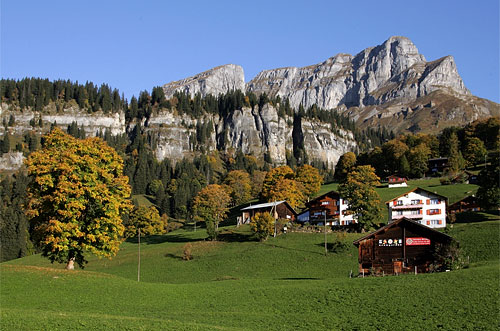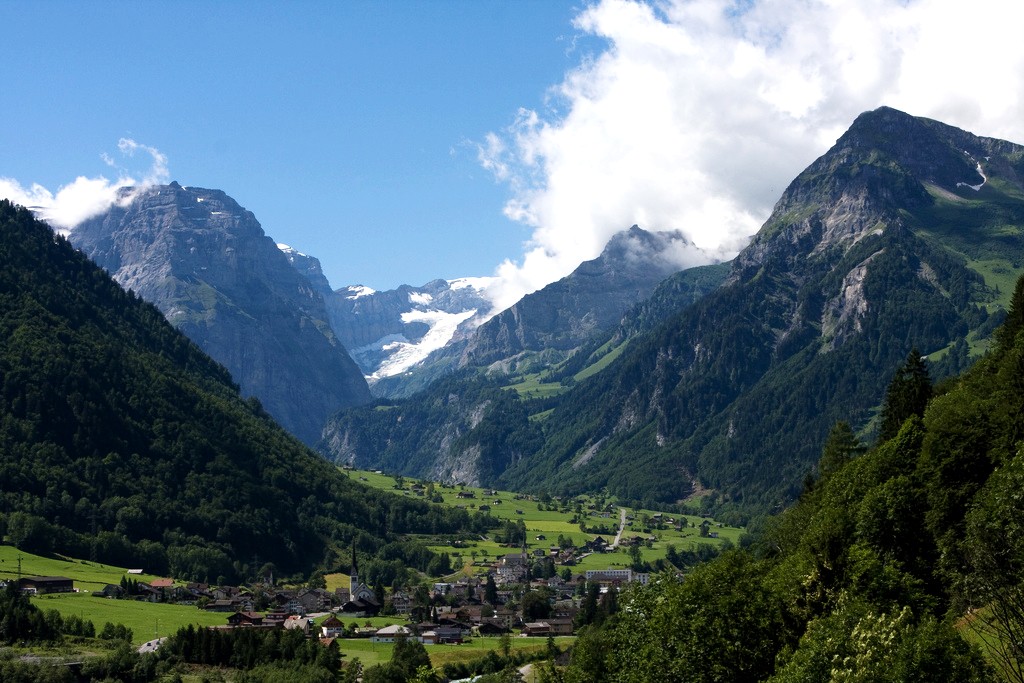|
Rüti GL Railway Station
Rüti GL railway station () is a railway station serving the village of Rüti in the municipality of Glarus Süd in the Swiss canton of Glarus (abbreviated to GL).The station is situated on the Weesen to Linthal railway line, and served by the hourly Zürich S-Bahn service S25 between Zurich and Linthal. Services the following services call at Rüti GL: * St. Gallen S-Bahn: ** : hourly service between and via (only during off-peak hours). * Zürich S-Bahn The Zurich S-Bahn () system is a network of rail lines that has been incrementally expanded to cover the ZVV area, which comprises the entire canton of Zurich and portions of neighbouring cantons (Aargau, Glarus, Schaffhausen, Schwyz, ...: ** : hourly service between and via . References External links * Rüti GL Rüti GL {{Switzerland-railstation-stub ... [...More Info...] [...Related Items...] OR: [Wikipedia] [Google] [Baidu] |
Rüti, Glarus
Rüti is a village, and former municipality, in the municipality of Glarus Süd and canton of Glarus in Switzerland. History Rüti is first mentioned about 1340. Agriculture was the main industry in Rüti until the 19th century. However, by the 17th century, manual cotton spinning was widespread. By 1770 this had declined and the resulting impoverishment ended only with the establishment of a cotton mill for mechanical spinning and weaving of cotton in 1847, and a second similar plant for weaving both wool and cotton in 1850. These factories attracted many foreign workers to Rüti, but their operations ceased in 2002. In 1879, Linthal was connected to the Swiss railway network by the opening of the Swiss Northeastern Railway line from Weesen to Linthal. Until 1939, the village of Braunwald formed part of the municipality of Rüti, but in that year it split off to form its own municipality. On 1 January 2011, both municipalities was reunited as part of the new municipality of G ... [...More Info...] [...Related Items...] OR: [Wikipedia] [Google] [Baidu] |
Glarus Süd
Glarus Süd is a municipality in the Switzerland, Swiss canton of Glarus. It comprises the upper Linth valley, and the entire Sernf valley, and includes the villages of Betschwanden, Braunwald, Glarus, Braunwald, Diesbach, Glarus, Diesbach, Elm, Switzerland, Elm, Engi, Switzerland, Engi, Haslen, Glarus, Haslen, Hätzingen, Leuggelbach, Linthal, Glarus, Linthal, Luchsingen, Matt, Switzerland, Matt, Mitlödi, Nidfurn, Rüti, Glarus, Rüti, Schwanden, Glarus, Schwanden, Schwändi, near Schwanden, Glarus, Schwändi and Sool, Glarus, Sool. Glarus Süd is one of three municipalities of the canton of Glarus, the others being Glarus and Glarus Nord. History The municipality of Glarus Süd was created on 1 January 2011, incorporating the former municipalities of Betschwanden, Braunwald, Glarus, Braunwald, Elm, Glarus, Elm, Engi, Glarus, Engi, Haslen, Glarus, Haslen, Linthal, Glarus, Linthal, Luchsingen, Matt, Glarus, Matt, Mitlödi, Rüti, Glarus, Rüti, Schwanden, Glarus, Schwanden, Sc ... [...More Info...] [...Related Items...] OR: [Wikipedia] [Google] [Baidu] |
Canton Of Glarus
The canton of Glarus ( ; ; ; ) is a cantons of Switzerland, canton in east-central Switzerland. The capital is Glarus. The population speaks a variety of Alemannic German. The majority of the population (81%) identifies as Christianity in Switzerland, Christian, about evenly split between Swiss Reformed Church, Protestants and Roman Catholicism in Switzerland, Catholics. History According to legend, the inhabitants of the Linth Valley were converted to Christianity in the 6th century by the Hiberno-Scottish mission, Irish monk Fridolin of Säckingen, Saint Fridolin, the founder of Säckingen Abbey in what is now the Germany, German state of Baden-Württemberg. From the 9th century, the area around Glarus was owned by Säckingen Abbey, the town of Glarus being recorded as ''Clarona''. The Alemanni began to settle in the valley in the early 8th century. The Alemannic German language took hold only gradually and was dominant by the 11th century. By 1288, the Habsburgs had claimed ... [...More Info...] [...Related Items...] OR: [Wikipedia] [Google] [Baidu] |
Swiss Federal Railways
Swiss Federal Railways (, SBB; , CFF; , FFS) is the national railway company of Switzerland. The company was founded in 1902 and is headquartered in Bern. It used to be a State-owned enterprise, government institution, but since 1999 it has been a special stock corporation whose shares are held by the Swiss Confederation and the Cantons of Switzerland, Swiss cantons. It is the largest rail and transport company of Switzerland; it operates on most standard gauge lines of the Rail transport in Switzerland, Swiss railway network. It also heavily collaborates with most other transport companies of the country, such as the BLS AG, BLS, one of its main competitors, or (SOB), to provide fully integrated public transport timetable, timetables with Clock-face scheduling, cyclic schedules. SBB was ranked first among national Rail transport in Europe, European rail systems in the 2017 European Railway Performance Index for its intensity of use, quality of service, and safety rating. Whil ... [...More Info...] [...Related Items...] OR: [Wikipedia] [Google] [Baidu] |
Railway Station
Rail transport (also known as train transport) is a means of transport using wheeled vehicles running in railway track, tracks, which usually consist of two parallel steel railway track, rails. Rail transport is one of the two primary means of land transport, next to road transport. It is used for about 8% of passenger and rail freight transport, freight transport globally, thanks to its Energy efficiency in transport, energy efficiency and potentially high-speed rail, high speed.Rolling stock on rails generally encounters lower friction, frictional resistance than rubber-tyred road vehicles, allowing rail cars to be coupled into longer trains. Power is usually provided by Diesel locomotive, diesel or Electric locomotive, electric locomotives. While railway transport is capital intensity, capital-intensive and less flexible than road transport, it can carry heavy loads of passengers and cargo with greater energy efficiency and safety. Precursors of railways driven by human or an ... [...More Info...] [...Related Items...] OR: [Wikipedia] [Google] [Baidu] |
Switzerland
Switzerland, officially the Swiss Confederation, is a landlocked country located in west-central Europe. It is bordered by Italy to the south, France to the west, Germany to the north, and Austria and Liechtenstein to the east. Switzerland is geographically divided among the Swiss Plateau, the Swiss Alps, Alps and the Jura Mountains, Jura; the Alps occupy the greater part of the territory, whereas most of the country's Demographics of Switzerland, 9 million people are concentrated on the plateau, which hosts List of cities in Switzerland, its largest cities and economic centres, including Zurich, Geneva, and Lausanne. Switzerland is a federal republic composed of Cantons of Switzerland, 26 cantons, with federal authorities based in Bern. It has four main linguistic and cultural regions: German, French, Italian and Romansh language, Romansh. Although most Swiss are German-speaking, national identity is fairly cohesive, being rooted in a common historical background, shared ... [...More Info...] [...Related Items...] OR: [Wikipedia] [Google] [Baidu] |
Canton Of Glarus
The canton of Glarus ( ; ; ; ) is a cantons of Switzerland, canton in east-central Switzerland. The capital is Glarus. The population speaks a variety of Alemannic German. The majority of the population (81%) identifies as Christianity in Switzerland, Christian, about evenly split between Swiss Reformed Church, Protestants and Roman Catholicism in Switzerland, Catholics. History According to legend, the inhabitants of the Linth Valley were converted to Christianity in the 6th century by the Hiberno-Scottish mission, Irish monk Fridolin of Säckingen, Saint Fridolin, the founder of Säckingen Abbey in what is now the Germany, German state of Baden-Württemberg. From the 9th century, the area around Glarus was owned by Säckingen Abbey, the town of Glarus being recorded as ''Clarona''. The Alemanni began to settle in the valley in the early 8th century. The Alemannic German language took hold only gradually and was dominant by the 11th century. By 1288, the Habsburgs had claimed ... [...More Info...] [...Related Items...] OR: [Wikipedia] [Google] [Baidu] |
Zürich S-Bahn
The Zurich S-Bahn () system is a network of rail lines that has been incrementally expanded to cover the ZVV area, which comprises the entire canton of Zurich and portions of neighbouring cantons (Aargau, Glarus, Schaffhausen, Schwyz, St. Gallen, Thurgau and Zug), with a few lines extending into or crossing the territory of southern Germany. The network is one of many commuter rail operations in German speaking countries to be described as an S-Bahn. The lines connect with services of Aargau S-Bahn to the West, Basel S-Bahn (only in ) and Schaffhausen S-Bahn to the North, St. Gallen S-Bahn to the East, and Lucerne S-Bahn/Zug Stadtbahn to the South, as well as with InterCity, InterRegio and RegioExpress services at major junction stations. The entire ZVV S-Bahn network went into operation in May 1990, although many of the lines were already in operation. Unusual among rapid transit services, the Zurich S-Bahn provides first class commuter travel; about a quarter o ... [...More Info...] [...Related Items...] OR: [Wikipedia] [Google] [Baidu] |
S25 (ZVV)
The S25 is a regional railway line of the S-Bahn Zürich on the Zürcher Verkehrsverbund (ZVV), Zürich transportation network, and is one of the network's lines connecting the cantons of Zürich with Schwyz, Glarus and St. Gallen. The line was introduced in July 2014, and replaces the less frequent Glarner Sprinter train. At , trains of the S25 service usually depart from ground-level tracks () 3–18. History Between 1918 and 2004, there was no direct connection from the canton of Glarus to the city of Zürich. In 2004, the through Glarner Sprinter train was introduced, but financial and technical limitations meant this train only ran every two hours on weekdays, and twice a day on weekends and holidays. It also only reached Linthal, the terminus of the line in Glarus, on weekends and holidays. In July 2014, these limitations were finally overcome, and the Glarner Sprinter was replaced by the hourly S25 service to Linthal. Route * The line links Zürich Hauptbahnhof ... [...More Info...] [...Related Items...] OR: [Wikipedia] [Google] [Baidu] |
Zurich
Zurich (; ) is the list of cities in Switzerland, largest city in Switzerland and the capital of the canton of Zurich. It is in north-central Switzerland, at the northwestern tip of Lake Zurich. , the municipality had 448,664 inhabitants. The Urban agglomeration, urban area was home to 1.45 million people (2020), while the Zurich Metropolitan Area, Zurich metropolitan area had a total population of 2.1 million (2020). Zurich is a hub for railways, roads, and air traffic. Both Zurich Airport and Zürich Hauptbahnhof, Zurich's main railway station are the largest and busiest in the country. Permanently settled for over 2,000 years, Zurich was founded by the Roman Empire, Romans, who called it '. However, early settlements have been found dating back more than 6,400 years (although this only indicates human presence in the area and not the presence of a town that early). During the Middle Ages, Zurich gained the independent and privileged status of imperial immediacy and, in 1519 ... [...More Info...] [...Related Items...] OR: [Wikipedia] [Google] [Baidu] |
Linthal, Glarus
Linthal is a village and former municipality in the municipality of Glarus Süd and canton of Glarus in Switzerland. The village lies near the head of the valley of the Linth river, and at the foot of the Klausen Pass into the canton of Uri. It is the terminus of the railway line that traverses the length of Glarus. History Linthal is first mentioned in 1289 as ''Lintal''. In 1879, Linthal was connected to the Swiss railway network by the opening of the Swiss Northeastern Railway line from Weesen. The road over the Klausen Pass was built between 1895 and 1900. Construction of the Linth–Limmern Power Stations, Linth–Limmern hydro-electric power scheme, in the mountains above Linthal, commenced in 1957, and was fully operational by 1968. In 2011, the municipality of Linthal was merged into the new municipality of Glarus Süd. Geography The village Linthal lies at the head of the valley of the Linth river, at an altitude of approximately . It is surrounded by mountains, incl ... [...More Info...] [...Related Items...] OR: [Wikipedia] [Google] [Baidu] |





